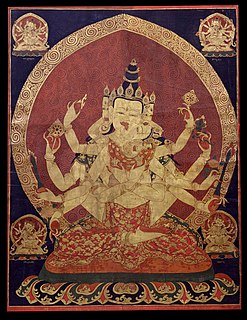| |||||
| Decades: | |||||
|---|---|---|---|---|---|
| See also: | Other events of 1694 History of China • Timeline • Years | ||||
Events from the year 1694 in China .
| |||||
| Decades: | |||||
|---|---|---|---|---|---|
| See also: | Other events of 1694 History of China • Timeline • Years | ||||
Events from the year 1694 in China .

The Qing dynasty, officially the Great Qing, was the last imperial dynasty of China. It was established in 1636, and ruled China proper from 1644 to 1912. It was preceded by the Ming dynasty and succeeded by the Republic of China. The multiethnic Qing empire lasted for almost three centuries and formed the territorial base for modern China. It was the fourth largest empire in world history in terms of territorial size.

The Kangxi Emperor, given name Xuanye, was the third Emperor of the Qing dynasty, and the second Qing emperor to rule over China proper.

The Niujie Mosque(simplified Chinese: 牛街礼拜寺; traditional Chinese: 牛街禮拜寺; pinyin: Niú Jiē Lǐ Bài Sì; Wade–Giles: Niu-chieh Li-pai-ssu "Oxen Street House of Worship" or Chinese: 牛街清真寺; pinyin: Niú Jiē Qīng Zhēn Sì; Wade–Giles: Niu-chieh Ch'ing-chen-ssu "Oxen Street Mosque") is the oldest mosque in Beijing, China. It was first built in 996 during the Liao Dynasty and was reconstructed as well as enlarged under the Kangxi Emperor of the Qing Dynasty.

Mongolia under Qing rule was the rule of the Qing dynasty over the Mongolian steppe, including the Outer Mongolian 4 aimags and Inner Mongolian 6 leagues from the 17th century to the end of the dynasty. "Mongolia" here is understood in the broader historical sense. The last Mongol Khagan Ligden saw much of his power weakened in his quarrels with the Mongol tribes, was defeated by the Manchus, and died soon afterwards. His son Ejei Khan gave Hong Taiji the imperial authority, ending the rule of Northern Yuan dynasty then centered in Inner Mongolia by 1635. However, the Khalkha Mongols in Outer Mongolia continued to rule until they were overrun by the Dzungars in 1690, and they submitted to the Qing dynasty in 1691.

The exact nature of relations between Tibet and the Ming dynasty of China (1368–1644) is unclear. Analysis of the relationship is further complicated by modern political conflicts and the application of Westphalian sovereignty to a time when the concept did not exist. The Historical Status of China's Tibet, a book published by the government of PRC, asserts that the Ming dynasty had unquestioned sovereignty over Tibet, pointing to the Ming court's issuing of various titles to Tibetan leaders, Tibetans' full acceptance of these titles, and a renewal process for successors of these titles that involved traveling to the Ming capital. Scholars within China also argue that Tibet has been an integral part of China since the 13th century and that it was thus a part of the Ming Empire. But most scholars outside China, such as Turrell V. Wylie, Melvin C. Goldstein, and Helmut Hoffman, say that the relationship was one of suzerainty, that Ming titles were only nominal, that Tibet remained an independent region outside Ming control, and that it simply paid tribute until the Jiajing Emperor (1521–1566), who ceased relations with Tibet.
The History of Yuan, also known as the Yuanshi, is one of the official Chinese historical works known as the Twenty-Four Histories of China. Commissioned by the court of the Ming dynasty, in accordance to political tradition, the text was composed in 1370 by the official Bureau of History of the Ming dynasty, under direction of Song Lian (1310–1381).

The Northern Yuan was a dynastic regime ruled by the Mongol Borjigin clan based in the Mongolian Plateau. It operated as a rump state after the collapse of the Yuan dynasty of China in 1368 and lasted until its conquest by the Jurchen-led Later Jin dynasty in 1635. The Northern Yuan dynasty began with the end of Yuan rule in China proper and the retreat of the Yuan remnants led by Toghon Temür to the Mongolian steppe. This period featured factional struggles and the often only nominal role of the Great Khan.

The Kumul Khanate was a semi-autonomous feudal Turkic khanate within the Qing dynasty and then the Republic of China until it was abolished by Xinjiang governor Jin Shuren in 1930. The khanate was located in present-day Hami prefecture of Xinjiang.

The Dzungar–Qing Wars (1687–1757) were a decades-long series of conflicts that pitted the Dzungar Khanate against the Qing dynasty of China and their Mongolian vassals. Fighting took place over a wide swath of Inner Asia, from present-day central and eastern Mongolia to Tibet, Qinghai, and Xinjiang regions of present-day China. Qing victories ultimately led to the incorporation of Outer Mongolia, Tibet and Xinjiang into the Qing Empire that was to last until the fall of the dynasty in 1911–1912, and the genocide of much of the Dzungar population in conquered areas.

Tibet under Qing rule refers to the Qing dynasty's rule over Tibet from 1720 to 1912. Tibet was under Khoshut Khanate rule from 1642 to 1717, with the Khoshuts conquered by Dzungar Khanate in 1717, and the Dzungars subsequently expelled by Qing in 1720. The Qing emperors appointed resident commissioners known as Ambans to Tibet, most of them are ethnic Manchus, who reported to the Lifan Yuan, a Qing government body that oversaw the empire's frontier. Tibet under Qing rule retained a degree of political autonomy under the Dalai Lamas nonetheless.

The Qing dynasty in Inner Asia was the expansion of the Qing dynasty's realm in Inner Asia in the 17th and the 18th century AD, including both Inner and Outer Mongolia, Manchuria, Tibet, Qinghai and Xinjiang.
Events from the year 1673 in China.
Events from the year 1675 in China.
Events from the year 1677 in China.
Events from the year 1680 in China.
Events from the year 1686 in China.
Events from the year 1690 in China.
Events from the year 1693 in China.